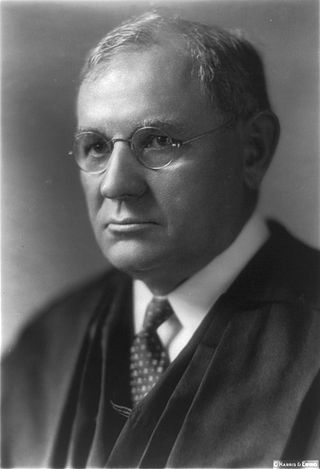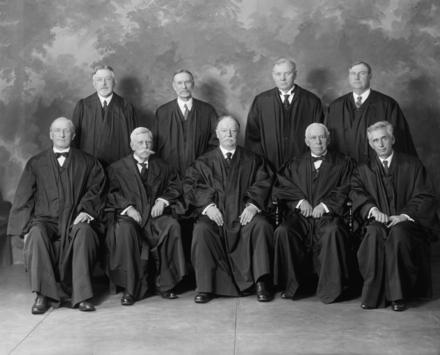
Charles Evans Hughes Sr. was an American statesman, politician, academic, and jurist who served as the 11th chief justice of the United States from 1930 to 1941. A member of the Republican Party, he previously was the 36th governor of New York (1907–1910), an associate justice of the Supreme Court (1910–1916), and 44th U.S. secretary of state (1921–1925). As the Republican nominee in the 1916 presidential election, he lost narrowly to Woodrow Wilson.

William Howard Taft was the 27th president of the United States, serving from 1909 to 1913, and the tenth chief justice of the United States, serving from 1921 to 1930, the only person to have held both offices. Taft was elected president in 1908, the chosen successor of Theodore Roosevelt, but was defeated for reelection in 1912 by Woodrow Wilson after Roosevelt split the Republican vote by running as a third-party candidate. In 1921, President Warren G. Harding appointed Taft to be chief justice, a position he held until a month before his death.
Gitlow v. New York, 268 U.S. 652 (1925), was a landmark decision of the United States Supreme Court holding that the Fourteenth Amendment to the United States Constitution had extended the First Amendment's provisions protecting freedom of speech and freedom of the press to apply to the governments of U.S. states. Along with Chicago, Burlington & Quincy Railroad Co. v. City of Chicago (1897), it was one of the first major cases involving the incorporation of the Bill of Rights. It was also one of a series of Supreme Court cases that defined the scope of the First Amendment's protection of free speech and established the standard to which a state or the federal government would be held when it criminalized speech or writing.

Harlan Fiske Stone was an American attorney and jurist who served as an associate justice of the U.S. Supreme Court from 1925 to 1941 and then as the 12th chief justice of the United States from 1941 until his death in 1946. He also served as the U.S. Attorney General from 1924 to 1925 under President Calvin Coolidge, with whom he had attended Amherst College as a young man. His most famous dictum was: "Courts are not the only agency of government that must be assumed to have capacity to govern."

Pierce Butler was an American jurist who served as an associate justice of the Supreme Court of the United States from 1923 until his death in 1939. He was a staunch conservative and was regarded as a part of the Four Horsemen, the conservative bloc that dominated the Supreme Court during the 1930s. A devout Catholic, he was also the sole dissenter in the later case Buck v. Bell, though he did not write an opinion.

The Judicial Procedures Reform Bill of 1937, frequently called the "court-packing plan", was a legislative initiative proposed by U.S. President Franklin D. Roosevelt to add more justices to the U.S. Supreme Court in order to obtain favorable rulings regarding New Deal legislation that the Court had ruled unconstitutional. The central provision of the bill would have granted the president power to appoint an additional justice to the U.S. Supreme Court, up to a maximum of six, for every member of the court over the age of 70 years.

The lists of law clerks of the Supreme Court of the United States cover the law clerks who have assisted the justices of the Supreme Court of the United States in various capacities since the first one was hired by Justice Horace Gray in 1882. The list is divided into separate lists for each position in the Supreme Court.

Willis Van Devanter was an American lawyer who served as an associate justice of the Supreme Court of the United States from 1911 to 1937. He was a staunch conservative and was regarded as a part of the Four Horsemen, the conservative bloc which dominated the Supreme Court during the 1930s.

Edward Terry Sanford was an American jurist who served as an associate justice of the Supreme Court of the United States from 1923 until his death in 1930. Prior to his nomination to the high court, Sanford served as a United States Assistant Attorney General under President Theodore Roosevelt from 1905 to 1907, and as a United States district judge of the United States District Court for the Eastern District of Tennessee and the United States District Court for the Middle District of Tennessee from 1908 to 1923. As of 2023, he is the last sitting district court judge to be elevated directly to the Supreme Court.
During his time in office, President Warren G. Harding appointed four members of the Supreme Court of the United States: Chief Justice William Howard Taft, and Associate Justices George Sutherland, Pierce Butler, and Edward Terry Sanford.
Block v. Hirsh, 256 U.S. 135 (1921), is a United States Supreme Court case which upheld a temporary rent control law in the District of Columbia. It set a precedent in American law that government can regulate housing conditions during times of emergency to maintain or improve living conditions.

The Waite Court refers to the Supreme Court of the United States from 1874 to 1888, when Morrison Waite served as the seventh Chief Justice of the United States. Waite succeeded Salmon P. Chase as Chief Justice after the latter's death. Waite served as Chief Justice until his death, at which point Melville Fuller was nominated and confirmed as Waite's successor.

The Hughes Court refers to the Supreme Court of the United States from 1930 to 1941, when Charles Evans Hughes served as Chief Justice of the United States. Hughes succeeded William Howard Taft as Chief Justice after the latter's retirement, and Hughes served as Chief Justice until his retirement, at which point Harlan Stone was nominated and confirmed as Hughes's replacement. The Supreme Court moved from its former quarters at the United States Capitol to the newly constructed Supreme Court Building during Hughes's chief-justiceship.

The Stone Court refers to the Supreme Court of the United States from 1941 to 1946, when Harlan F. Stone served as Chief Justice of the United States. Stone succeeded the retiring Charles Evans Hughes in 1941, and served as Chief Justice until his death, at which point Fred Vinson was nominated and confirmed as Stone's replacement. He was the fourth chief justice to have previously served as an associate justice and the second to have done so without a break in tenure. Presiding over the country during World War II, the Stone Court delivered several important war-time rulings, such as in Ex parte Quirin, where it upheld the President's power to try Nazi saboteurs captured on American soil by military tribunals. It also supported the federal government's policy of relocating Japanese Americans into internment camps.

The Vinson Court refers to the Supreme Court of the United States from 1946 to 1953, when Fred M. Vinson served as Chief Justice of the United States. Vinson succeeded Harlan F. Stone as Chief Justice after the latter's death, and Vinson served as Chief Justice until his death, at which point Earl Warren was nominated and confirmed to succeed Vinson.

The White Court refers to the Supreme Court of the United States from 1910 to 1921, when Edward Douglass White served as Chief Justice of the United States. White, an associate justice since 1894, succeeded Melville Fuller as Chief Justice after the latter's death, and White served as Chief Justice until his death a decade later. He was the first sitting associate justice to be elevated to chief justice in the Court's history. He was succeeded by former president William Howard Taft.

The Fuller Court refers to the Supreme Court of the United States from 1888 to 1910, when Melville Fuller served as the eighth Chief Justice of the United States. Fuller succeeded Morrison R. Waite as Chief Justice after the latter's death, and Fuller served as Chief Justice until his death, at which point Associate Justice Edward Douglass White was nominated and confirmed as Fuller's replacement.
Milwaukee Social Democratic Publishing Company v. Burleson, 255 U.S. 407 (1921), was a Supreme Court ruling that upheld the United States Postmaster General's power to revoke second-class mail privileges under the Espionage Act of 1917. The lawsuit was filed on behalf of the owners of the Milwaukee Leader, a socialist daily newspaper in Milwaukee, Wisconsin due to Postmaster General Albert S. Burleson's revocation of the Leader's second-class mailing privileges on the grounds of past anti-war articles it had published. The court ruled 7–2 in favor of the federal government, with Justice Clarke delivering the majority opinion while Justices Louis Brandeis and Oliver Wendell Holmes Jr. dissented.
The New Deal often encountered heavy criticism, and had many constitutional challenges.


















